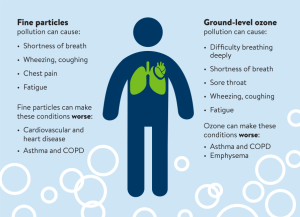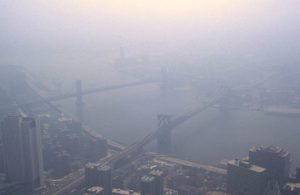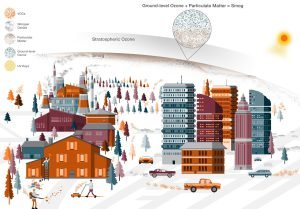Smog is a type of air pollution. it can negatively impact visibility. The term “smog” was first coined in the early 1900s to describe a mixture of smoke and fog. Usually, it came from burning coal. it was common in industrial areas of cities – making it a familiar sight for many. Nowadays, most of the smog we see is photochemical smog.

TYPES OF SMOG:
There are two main types of it: Los Angeles smog and London smog. Los Angeles smog forms in the summer months and is found mainly in subtropical zones. London smog forms mainly from November to January (sometimes March) and is more characteristic of the temperate climatic zone. These two types of smog also differ in composition. London smog is primarily made up of various particulate matter, which is enriched with sulfur, nitrogen, or carbon oxides. On the other hand, Los Angeles smog consists mainly of gases, including carbon oxides, nitrogen oxides, and hydrocarbons.
THE MAIN CAUSES OF it:
It is a mixture of air, pollutants, and exhaust gases that is often brown or gray in color. These pollutants come from human activities, such as factories and cars, burning coal, wood, and other solid fuels. The formation of it is also determined by the weather, climate, and general conditions of the area.
Nitrogen oxides and VOCs are two of the main contributors to smog formation. Nitrogen oxides come from car exhaust, coal power plants, and factory emissions. While VOCs have come from gasoline, paints, and many cleaning solvents. When sunlight hits these chemicals, they react and form airborne particles and ground-level ozone—or smog.

SMOG EFFECTS ON HUMAN HEALTH:
It is a mixture of pollutants in the air that can be harmful to our health. Causing respiratory disorders, cardiovascular dysfunction, neurological disorders, and cancer. Children and pregnant women are especially susceptible to the dangers of smog.
It is dangerous for our health because it increases our risk of developing serious heart and lung diseases when inhaled. Because of this, many cities monitor their smog levels closely. On days when the ozone is high, for example, you may experience burning eyes and throat, coughing, and wheezing.
Smog affects our respiratory system :
Diseases such as asthma, obstructive pulmonary disease (COPD), or cancer (lung, larynx, throat) have a clear link to exposure to it. While these diseases can develop without exposure to it due to some genetic dispositions, the pollutant can worsen symptoms or even initiate them. its influence on the human body can be compared to passive smoking – the implications of both are similar.
Smog is also dangerous for other body systems:
It can cause serious health problems because it’s full of particulate matter which can be inhaled deep into the lungs. The particles are so small that they can enter the bloodstream and be transported to various organs where they can accumulate and cause dysfunctions. it affects particularly the circulatory system, lifting the blood pressure and interfering with the heart rate. These implications can elevate the risk of cardiac arrest and strokes.

SMOG AFFECTS ON ENVIRONMENT:
Smoggy air not only inhibits plant growth and causes damage to crops and forests, but also contains ground-level ozone. This gas is especially harmful to soybeans, wheat, tomatoes, peanuts, and cotton. Furthermore, has mortifying impacts on the environment by killing innumerable animal species and green life, as these organisms lack the ability to adapt to breathing and surviving in such toxic environments.
It has become a devastating problem in recent years, due to the rapid modernization and industrialization of our world. The hazardous chemicals involved in its formation are highly reactive and spread easily through the atmosphere. Smoke and sulfur dioxide pollution in urban areas has decreased significantly as a result of laws passed to control emissions and promote cleaner emission Technology.

How can we protect ourselves from smog:
- Try to limit your outdoor activities as much as possible.
- Choose a face mask that is effective in protecting you from harmful particles in the air.
- Make sure you’re surrounded by clean air as much as possible – close windows, use air conditioners and air purifiers, and so on.
- Drinking lots of water and other healthy juices is a great way to cleanse your body and blood of harmful pollutants.
- It’s important to be informed about air quality in your area, especially if you suffer from allergies or respiratory problems. Check daily air-quality alerts to stay up-to-date on the current conditions.
- Burning firewood and trash are two of the leading causes of particle pollution in the air, especially in more rural areas.

Smog is a type of air pollution that is made up of chemicals and tiny particles that are released into the air, which then react with sunlight to form a thick, smoky haze. It was once commonly seen in industrial areas, but today it can be seen in cities all around the world. photochemical smog is the most common type of it that we see today.




